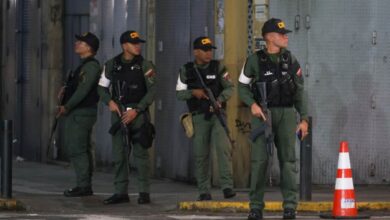Coronavirus dulls the Lunar New Year
Amid red lanterns, paper clippings and other significant objects to welcome the new Chinese year, the great Asian country has received the year of the metal rat plunged into one of the most important health crises of recent times. Baptized as 2019-nCoV, and called coronavirus, it has set alarms for its rapid contagion.

Lanterns celebrating the lunar new year. / Photo: Pixabay – Reference Image
LatinAmerican Post | Laura Guevara
Listen to this article
Leer en español: El Coronavirus opaca el Año Nuevo Lunar
According to a study by the Chinese Academy of Sciences of Beijing, it was discovered that the coronavirus would be related to a strain that is present in bats, and that it would have mutated when it came into contact with another animal species, which research suggests could be snakes. As a result, a new protein was developed, which was able to stick to human respiratory cells.
The first hypothesis that was managed to understand the contact between human and animal, and so far the most accepted, was that it began in the Wuhan market, a place where there are all kinds of animals together without any sanitary control. CNN had the possibility of releasing the images of this market where it is seen, for example, how sea urchins are manipulated without any protection and handled on surfaces that still contain fluids of other species. The market remains closed since January 1.
Also read: Women at higher risk of heart diseases at a younger age
The first measures
Before the rapid infection and the appearance of new cases, the Chinese authorities have stated that the coronavirus is contagious during the incubation period, around eleven million people in Wuhan remain isolated since January 22. As if it were a ghost town, there are few people on the streets, and those who leave have to wear masks, one of the first objects that quickly sold out in the city's supermarkets.
However, isolating the city of Wuhan was not enough. Xi Jinping, president of China, said that "the progress of the coronavirus is accelerating and we face a serious situation," according to statements collected by El Clarín. Given this, about 18 cities in the central Chinese region have been restricted by the travel ban, which affects 56 million people.
For regions that do not yet have a total restriction on transport systems, the Chinese authorities ordered measures for the detection of the virus in buses, trains and airplanes, and thus prevent further propagation of the coronavirus. In this way, there will be inspection points and those who have “pneumonia symptoms will be immediately transferred to a medical center,” according to DW.
At the time of writing this article, more than 2,000 cases of infection and 56 people have been reported dead in China. Of the deaths reported, it was confirmed that one of them was that of doctor Liang Wudong, 62, who had been attending to the victims in the so-called "first line".
Doctor Liang Wudong at the ENT department of Hubei Xinhua Hospital who had been at the front line fighting against #nCoV2019 in Wuhan, died from the virus on Sat at the age of 62. #RIP pic.twitter.com/kahysasuIB
— People's Daily, China (@PDChina) January 25, 2020
China counteracts the virus
Faced with hospital and drug crises that attack the city where the virus originated, the Chinese authorities confirmed the construction of two hospitals to deal with the virus. The first will be built in six days and will have the capacity of 1,000 beds. The second will last around fifteen days under construction, but it will have 1,300 beds available for infected people.
Along with the spread of the virus, Chinese scientists are trying to find a vaccine that can isolate the coronavirus. In this way, the Shanghai Municipal Health Commission said that a 56-year-old woman, infected with the virus, was discharged from the improvement of symptoms.
In addition, the researchers of the Center for Disease Prevention and Control of China confirmed that they managed to “successfully isolate the first strain of the virus”, with this they would begin to develop a vaccine with which it is hoped to fight and eliminate the coronavirus.
Read also: Did the new virus reach Latin America?
The affected countries
Since Wuhan is one of the Chinese cities with the most connections to the rest of the world, it was no surprise that both Asian and European countries presented cases of infection. So far these are the countries with confirmed cases of the coronavirus, according to the World Health Organization (WHO):
So far there have been no known cases of infection in Latin America, however, the WHO has given a series of recommendations in which it is highlighted that when sneezing or coughing you have to cover your mouth with a handkerchief or with elbow flexion. In addition, if "you have a fever, cough and shortness of breath, seek medical attention soon and share your previous travel history with your health care provider," it is also recommended to avoid eating raw or undercooked animal products.
Finally, the Google Maps service launched a service where you see in real time how the coronavirus advances in the world:





